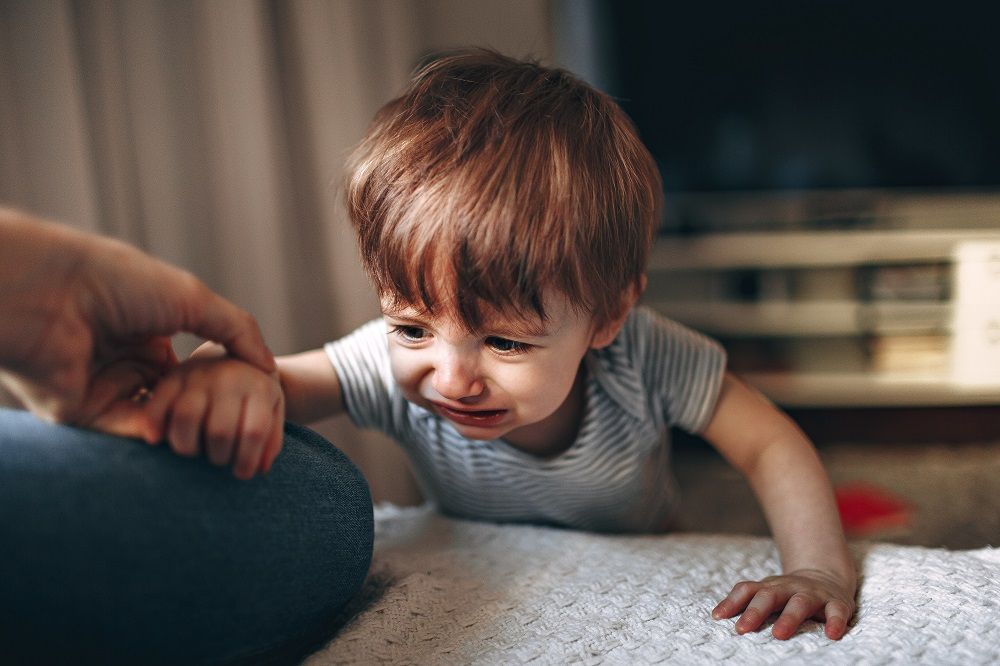How to help a child with anxiety
Key points:
- Occasional anxiety is common among children. Kids experiencing more serious anxiety may need additional support.
- It’s important to recognize the signs of more serious anxiety issues – for example, if your child’s anxiety is interfering with their day-to-day life.
- There are a few key steps you can take to help your child manage their anxiety – and a few key things to avoid doing, too.
It’s normal for children to experience anxiety. But what about when it’s more the just the usual worries that almost all children face from time to time – monsters under the bed, first day of school?
As many as 1 in 14 kids in the US are medically diagnosed with anxiety disorder. The rate is similar for kids in the UK. Many more children experience significant anxiety or worry on a regular basis. If anxiety is interfering with your child’s ability to function, it’s time to look for help.
But there is good news: given the right treatment and support, most children can learn strategies to manage anxiety and enjoy flourishing lives. Here’s what you need to know if your child is struggling with anxiety.
Causes of anxiety in children
There are a number of possible causes of anxiety in kids:
- Genes or temperament: for example, there is evidence that anxiety is common among children with ‘behavioral inhibition’, a temperament causing some kids to withdraw from unfamiliar circumstances or people.
- Learnt behavior: children pick up a lot of social cues from watching others – anxiety can be one of them.
- Lived experience: scary or stressful events in a child’s life can trigger anxiety.
Whatever your child’s experience may be, it’s important to recognize the signs of anxiety, so you know what to watch for.
Signs your child may be struggling with anxiety
Worry in and of itself is not a problem. All of us worry from time to time, including our kids. But how can you tell if your child is dealing with more than a normal amount of anxiety? There are a few questions you can ask.
An important note here: these questions should not be used to determine whether your child has an anxiety disorder. That’s a medical diagnosis that only a qualified healthcare professional can provide.
These questions can help you know when it’s time to get additional support:
- Is your child’s anxiety affecting their ability to complete basic, everyday tasks such as going to school or doing their homework?
- Does your child seem more anxious than other children their own age?
- How long has your child seemed more anxious than normal? If it lasts for more than a week or two, it may be more serious.
- Are they having trouble sleeping at night?
- Does your child complain about feeling unwell when there’s no obvious physical cause – for example, do they experience frequent headaches or stomach aches?
- Have they reverted to patterns or behaviors from when they were younger – for example, are they wetting the bed more often?
- Are they having meltdowns that seem out of character for their age?
- Have you noticed any compulsive behaviors like counting, tapping, or excessive hand washing?
- Does your child seem to need constant reassurance from you, or do they need more validation or reassurance from you than usual?
Remember, a yes to any or all of these questions does not automatically mean your child has an anxiety disorder. But they may be experiencing a higher than normal amount of anxiety. There are ways you can help – and a few mistakes to avoid.
How NOT to help a child with anxiety
Don’t try to ‘get rid of’ your child’s anxiety.
Your child is not ‘broken.’ Their anxiety is not something to be ‘solved’ or ‘gotten rid of.’ Anxiety can be managed, however, with the right treatment and support.
Don’t dismiss your child’s feelings.
Childhood worries may seem trivial from a grownup perspective. Rest assured: to your child, they’re anything but. Avoid the urge to tell them to simply ‘get over it.’
Don’t avoid every potentially triggering situation.
It might be tempting to steer clear of anything that feeds your child’s anxiety. While it’s important to be sensitive to what triggers it, avoidance is not a good long-term solution – especially if the source of their anxiety is something like school.
Don’t put off seeking help.
If their anxiety persists, consult a family physician or healthcare provider. Most anxiety disorders can improve with the right treatment and care.
Equip your child with tools to manage their anxiety
There are several ways you can help your child to manage their anxiety. But first, be sure to check your reaction when their anxiety comes out sideways. Responding with fear or frustration will only fuel their anxiety further.
Here are some calming strategies that can help your child when they feel anxious:
- Deep breathing exercises, inhaling and exhaling slowly
- Using a finger on one hand to trace their fingers on the other hand (perhaps combined with deep breathing)
- Meditation – for example, encouraging your child to picture a safe, relaxing place in their mind
- ‘Drawing their feelings’ or making art to express what’s worrying them
- Journaling – if your child is old enough, they may find it easier to write out what they’re feeling
If you as a parent are prone to feelings of anxiety, you may find some of these strategies helpful yourself.
Another key to helping your child manage their anxiety: make sure their daily routine includes plenty of the following:
- Outdoor physical activity
- Lots of sleep
- Healthy meals and snacks
- Plenty of family time

How to help your child without feeding their anxiety
As noted earlier, it’s generally impossible (and unwise) for your child to try to avoid every situation that might trigger their anxiety. What can you do instead? Several things, actually.
Try to follow these steps when your child is calm, not when they’re in the middle of whatever triggers their anxiety.
Encourage them to name their anxiety.
See if they can identify the situation they’re worried about, or what they think might happen.
Validate their feelings.
You may know the thing they’re worried about is unlikely to happen. That doesn’t make what they’re feeling any less valid. Be sure to verbally acknowledge their anxiety, without trivialising or dismissing it. For example: ‘I know you’re worried about…’, or, ‘I know it can be scary to think about…’
Talk about how they might handle their fear.
For example, if they’re anxious about going to school, try to understand what’s behind that fear. Talk about specific situations and ways they might respond. Discuss alternative scenarios: what might happen if whatever they’re afraid of doesn’t come to pass?
Offer physical reassurance.
But only when your child wants it. Some children crave physical reassurance from a parent when they’re anxious. It may be unhelpful for others. The smartest thing to do is ask first: ‘Would a quick snuggle help you feel better?’
Help them gradually face their fear.
It’s important to approach triggering situations with care, not avoidance. Give your child permission to feel their fear. (Fear in itself is not a bad thing.) But also gently encourage them to face their fear gradually. Don’t expect them to conquer their fears overnight. Instead, take it slow and celebrate the small victories along the way.
Many experts recommend using the ‘stepladder approach’ to help a child face their anxiety. Here’s how it works:
- Help your child identify their goal – something they want to achieve, but their anxiety is holding them back.
- List all the steps needed to achieve that goal, from least scary to scariest.
- Give each step a ‘worry rating’, on a scale from 1 to 10.
- Come up with rewards for achieving each step.
For example, if your child is afraid of dogs, you could work together to come up with a plan for a stepladder. Here is one example with a goal of ‘calmly petting a dog’:
Step 1: Look at photos of dogs together.
- Worry rating: 1
- Reward: Play a board game together.
Step 2: Watch a kid-friendly or movie featuring a dog (for example, Because of Winn Dixie).
- Worry rating: 2
- Reward: Go to a playground.
Step 3: Go to a park to look at dogs, but without approaching them.
- Worry rating: 4
- Reward: An extra book at bedtime.
Step 4: Visit a friend with a dog, but have them keep the dog in a different room.
- Worry rating: 6
- Reward: Invite their friend over to play.
Step 5: Visit your friend with a dog again, but this time have them bring the dog into the room, holding it at all times so there is no direct contact with your child.
- Worry rating: 8
- Reward: Go for ice cream after school.
Step 6: Visit a friend with a dog once more, but this time have your child pet or play with the dog while you stay in the room to provide reassurance.
- Worry rating: 9
- Reward: Go out for their favorite food.

Tips about stepladders
There are some tips to remember to make stepladders successful:
- Involve your child in developing them. This means listening to your child, asking them to help decide on the steps, and discussing rewards with them.
- If a step seems too hard, you and your child may need to adjust or stay on the same step for a while. Some stepladders will have more steps than the one above. It is important to make it a gradual process.
- Give specific praise when your child is successful (e.g., ‘you were brave today when visiting Max the dog’). When there is a setback, try not to get discouraged. Simply encourage the child to try again another time.
When to seek additional help
Your child may need more help managing their anxiety than what you can offer. That’s ok – they’re not alone, and neither are you.
If your child’s anxiety persists, or if it interferes with their ability to function day to day, consult a doctor or licensed therapist. There are treatments and coping strategies that may help. For example, cognitive behavioral therapy can teach kids with serious anxiety issues how to handle negative thoughts (which often feed their anxiety) and equip them with effective coping techniques.
The bottom line is: you don’t have to go it alone. You can equip your child with the tools and support they need to manage their anxiety.
Want to learn more?
Movember launched Family Man to improve the confidence and mental health of dads.
Learn how to master kick-ass parenting strategies by getting started with Family Man. It’s an interactive parenting video series that's expert-backed and funded by Movember.
If research is your thing take a closer look at the evidence behind Family Man.
Or learn more before diving in.